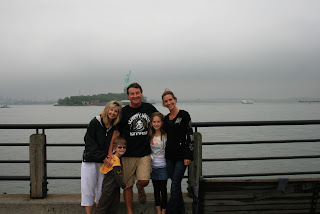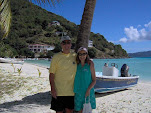From here we moved directly north across the top of Lake Huron to Drummond Island where we crashed for nine days. Now we felt we were truly home. We have slipped at Drummond Island Yacht Haven each summer for sixteen years, enjoying its laid back atmosphere, its gorgeous views and sunsets, and its fantastic biking and fishing opportunities.
 Here we met up with our good friends and dock mates, Dennis and Randi Nickels who have boated with us for many years in this part of the world. The last four days on the island were especially fun, as the Nickels' granddaughters, Emma and Julia, and two of ours, Jordan and Corey, came up to stay with us. Fellow loopers, Tom and Diane from "Noah Agenda", also spent a couple of days with us, and Andrew and Sallyann from "Freedom" joined us for a campfire picnic with s'mores on a small nearby island.
Here we met up with our good friends and dock mates, Dennis and Randi Nickels who have boated with us for many years in this part of the world. The last four days on the island were especially fun, as the Nickels' granddaughters, Emma and Julia, and two of ours, Jordan and Corey, came up to stay with us. Fellow loopers, Tom and Diane from "Noah Agenda", also spent a couple of days with us, and Andrew and Sallyann from "Freedom" joined us for a campfire picnic with s'mores on a small nearby island. Next, complete with grandkids, our two boats cruised to Mackinac Island where we spent four days enjoying the biking, the dining, the fudge, and the general ambiance of the place. Then, Mackinac City, where parents picked the grandkids.
While the Nickels moved south to Charlevoix, we stayed another day to greet daughter, Jennifer who had flown in from Connecticut along with her friend and our grandkids, Courtney and Carter. Then, back to the island to have fun with this part of our family for four more days plus an additional day in Mack City where we once again enjoyed the beauty of the Mack Bridge lit up at night.
Next we headed through the straits to Charlevoix, another of our favorite "up north" ports. Here we again made rendezvous with the Nickels who were slipped at the Municipal Marina on Round Lake near downtown. Rather than staying downtown, this trip we chose to stay on Lake Charlevoix on the wall at Irish Boat Shop, where the lake views are spectacular.
After three days, we left for Leland on the Leelanau Peninsula. Twice Linda and I biked the fifteen miles around Lake Leelanau and once biked the twenty one mile round trip to the neat little town of Suttons Bay, one of the crown jewels of Grand Traverse Bay. Leland is full of fun shops and restaurants, many situated along a river in the city's historic "Fish Town". It's also noted as a site from which to watch world class sunsets.
We next pulled into Frankfort, where we were weathered in for five days because of seas which ranged from five to eleven feet each day. No problem. If you have to be weathered in, this is the place to be. Frankfort is a great place to kick back, swim, hike fish, eat, or whatever. Its Betsie River Trail, which goes for miles along an old railroad bed to pristine Crystal Lake and beyond, is one of the most scenic bike and hike trails anywhere on the loop.
Finally, on August 20, 2010, after 117 miles more, we pulled into the Grand Haven channel, gold burgee flying. We felt powerful but mixed emotions cruising the last five miles of the loop down the Grand River to our marina on Spring Lake. Sure, we felt happy to be back home safe and sound, in familiar, happy surroundings. But we also felt a bit of sadness over the finality of our great adventure; the completion of a six thousand mile journey, itself the culmination of years of dreaming and planning. What helped us snap out of our melancholy, though, was the cheers of our marina friends who had gathered on the dock to welcome us into our slip with hugs, high fives, and balloons.
 People ask us if we would do it again. I asked Linda what she thought, and her response summed of both our feelings perfectly when she said, "Don't sell the charts and guidebooks. You never know"! We wouldn't want to do it again right away. The trip is exhilarating, but it's also exhausting. With skinny water, seventy five locks, and always the possibility of bad weather or mechanical issues, its can be hard work and stressful at times. But the trip was even better than the dream. Maybe again. Maybe in a couple of years if all goes well.
People ask us if we would do it again. I asked Linda what she thought, and her response summed of both our feelings perfectly when she said, "Don't sell the charts and guidebooks. You never know"! We wouldn't want to do it again right away. The trip is exhilarating, but it's also exhausting. With skinny water, seventy five locks, and always the possibility of bad weather or mechanical issues, its can be hard work and stressful at times. But the trip was even better than the dream. Maybe again. Maybe in a couple of years if all goes well.Two final thoughts. First, Linda and I are still working and we realized we could not have done this trip without the help and support of our office staff and colleagues back home. To them we owe our profound thanks.
Second, we want to salute our "looper cat", Schatze, who boasting 4.8 pounds of fighting weight and nearly twenty years of experience and determination, traveled 6,000 miles by boat and 8,000 miles by car (back and forth to Michigan). Traveling 14,000 total miles, she never complained--though she did get seasick four times--and she earned our enduring admiration. Way to go "Schat's"!
































































